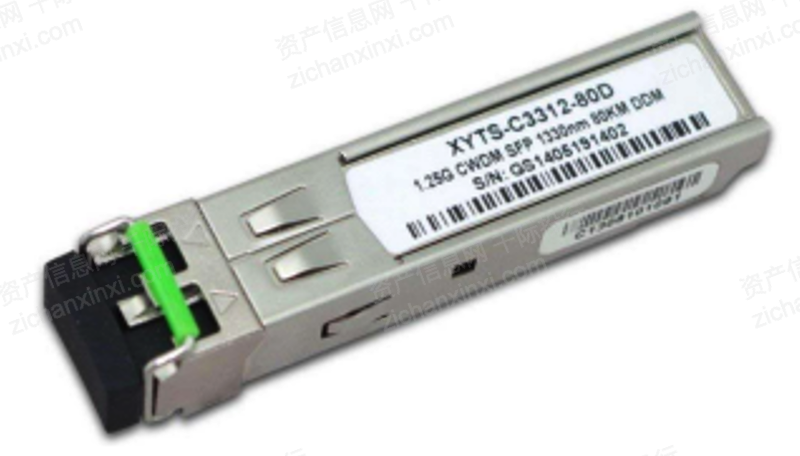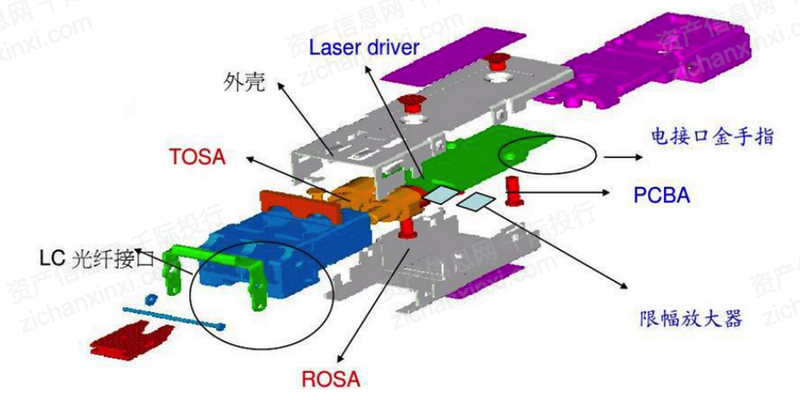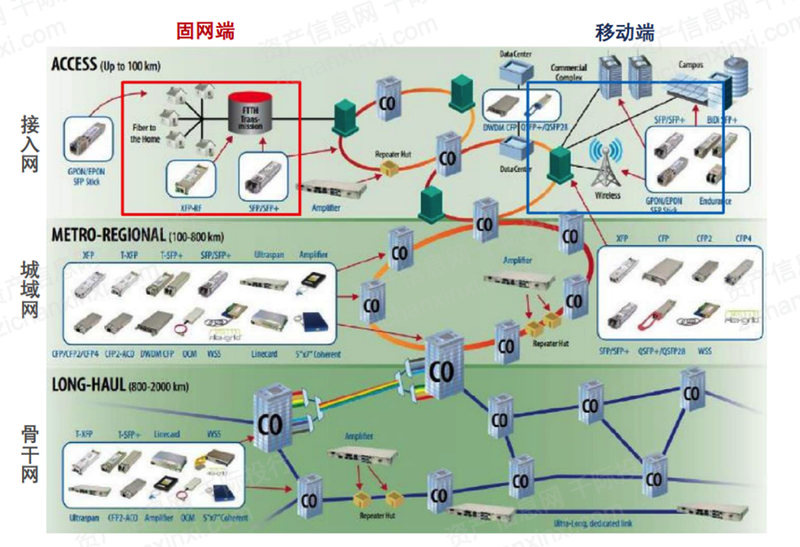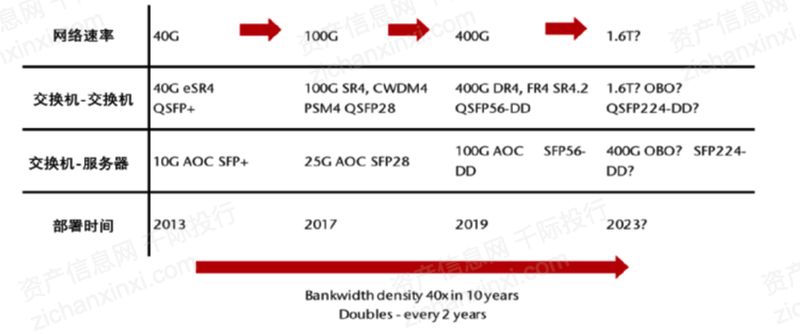Optical Module Industry Research Report 2022 - Industry Overview (1)
Industry Overview
Optical Module (Optical Module) consists of optoelectronic devices, functional circuits and optical interfaces, etc. The optoelectronic devices include two parts: transmitting and receiving. The role of the optical module is photoelectric conversion, the transmitter side of the electrical signal into optical signals, through the fiber optic transmission, the receiver side and then convert the optical signal into electrical signals.
The transmitting part: input a certain code rate of the electrical signal by the internal driver chip processing to drive the semiconductor laser (LD) or light-emitting diode (LED) to emit the corresponding rate of modulated light signal, its internal with optical power automatic control circuit, so that the output optical signal power to maintain stability.
Receiving part: The light signal of certain code rate is input to the module and then converted into electric signal by light detecting diode, and the electric signal of corresponding code rate is output after the preamplifier.
图:光模块产品

资料来源:千际投行,资产信息网,华辰资本
Structure
Optical module consists of optical devices, functional circuits and optical interface components, etc. The core components are optical transceiver devices, mainly including TOSA, ROSA, BOSA. optical transceiver devices account for more than 60% of the cost of the optical module.
Optical transmitting component TOSA (Transmitter Optical Subassembly): lasers, metal structural parts and ceramic inserts, etc..
optical receiver assembly ROSA (Receiver Optical Subassembly): PIN or APD detectors, preamplifiers and other structural components.
Optical transmitter-receiver assembly BOSA (Biodirector Optical Subassembly): lasers, detectors, optical filters, metal parts, ceramic sleeves and inserts.
图:光模块结构示意图

资料来源:千际投行,资产信息网,华辰资本
Classification
Optical modules can be classified according to package form, transmission rate, and network topology.
Classification by package form: optical modules can be classified as 1×9, GBIC, SFF, SFP, XFP, SFP+, SFP28, CFP4, QSFP, etc.
According to the transmission rate classification: optical modules can be divided into 155Mb / s, 622Mb / s, 1.25Gb / s, 2.5Gb / s, 2.97Gb / s, 4.25Gb / s, 6.5Gb / s, 8.5Gb / s, 10Gb / s, 25Gb / s, 40Gb / s, 100Gb / s, 200Gb / s, 400Gb / s, etc.. Transmission rate is an important technical indicator of optical modules, high speed is the development trend.
According to the network topology classification: can be divided into point-to-point optical module and point-to-multipoint optical module (PON optical module), the former is mainly used in data centers, backbone networks, metropolitan networks, etc.; the latter is mainly used in passive optical networks (PON) of access networks, such as GPON, EPON, 10GPON, etc.
Application areas
(1) Telecom market
Optical modules in the telecom market applications are divided into fixed-end and mobile-end: fixed-end from the fiber optic access network linkage to the metro network, long-distance backbone network; mobile-end from the base station of the forward linkage to backhaul, metro network, long-distance backbone network.
Access network (Access): GPON → 10GPON, currently mainly using active SFP +, FTTH scenarios using passive GPON splitting modules.
Metro-Regional network (Metro-Regional): 10G/40G→100G, currently mainly using SFP+, QSFP+, and partly using CFP and other related modules.
Backbone network (Long-haul): 100G→400G, currently mainly using CFP2 and other related modules.
图:光模块电信市场应用图谱

资料来源:千际投行,资产信息网,天风证券
(2) Data Communication Market
100G has become the mainstream of cloud computing data center. Data traffic continues to grow, the trend of data center large-scale, flattened to promote the development of optical modules to two aspects: transmission rate demand upgrade, the number of demand growth. At present, the global data center optical module demand has 10/40G optical module to 100G optical module turnover.
Global optical device leader OCLARO, since 2016, Amazon, Google and other North American first-tier cloud service providers server port began to upgrade from 10G to 25G, leaf, ridge switch port from 40G to 100G upgrade, is expected to start deploying 200 / 400G products in 2018.
For domestic vendors, Ali cloud publicity 2018 will become the first year of large-scale application of 100G optical modules, is expected to be the second half of 2019 for 400G optical module upgrade.
Access layer: connecting servers to the lower layer switches, with 10GSFP or DAC modules.
Aggregation layer: connection to lower layer switches with 40GQSFP+ modules.
Core layer: Connectivity to lower layer switches is dominated by 100GQSFP28 modules.
图:阿里云光模块演进路径

资料来源:千际投行,资产信息网,中信证券
Industry Overview
Optical Module (Optical Module) consists of optoelectronic devices, functional circuits and optical interfaces, etc. The optoelectronic devices include two parts: transmitting and receiving. The role of the optical module is photoelectric conversion, the transmitter side of the electrical signal into optical signals, through the fiber optic transmission, the receiver side and then convert the optical signal into electrical signals.
The transmitting part: input a certain code rate of the electrical signal by the internal driver chip processing to drive the semiconductor laser (LD) or light-emitting diode (LED) to emit the corresponding rate of modulated light signal, its internal with optical power automatic control circuit, so that the output optical signal power to maintain stability.
Receiving part: The light signal of certain code rate is input to the module and then converted into electric signal by light detecting diode, and the electric signal of corresponding code rate is output after the preamplifier.
图:光模块产品

资料来源:千际投行,资产信息网,华辰资本
Structure
Optical module consists of optical devices, functional circuits and optical interface components, etc. The core components are optical transceiver devices, mainly including TOSA, ROSA, BOSA. optical transceiver devices account for more than 60% of the cost of the optical module.
Optical transmitting component TOSA (Transmitter Optical Subassembly): lasers, metal structural parts and ceramic inserts, etc..
optical receiver assembly ROSA (Receiver Optical Subassembly): PIN or APD detectors, preamplifiers and other structural components.
Optical transmitter-receiver assembly BOSA (Biodirector Optical Subassembly): lasers, detectors, optical filters, metal parts, ceramic sleeves and inserts.
图:光模块结构示意图

资料来源:千际投行,资产信息网,华辰资本
Classification
Optical modules can be classified according to package form, transmission rate, and network topology.
Classification by package form: optical modules can be classified as 1×9, GBIC, SFF, SFP, XFP, SFP+, SFP28, CFP4, QSFP, etc.
According to the transmission rate classification: optical modules can be divided into 155Mb / s, 622Mb / s, 1.25Gb / s, 2.5Gb / s, 2.97Gb / s, 4.25Gb / s, 6.5Gb / s, 8.5Gb / s, 10Gb / s, 25Gb / s, 40Gb / s, 100Gb / s, 200Gb / s, 400Gb / s, etc.. Transmission rate is an important technical indicator of optical modules, high speed is the development trend.
According to the network topology classification: can be divided into point-to-point optical module and point-to-multipoint optical module (PON optical module), the former is mainly used in data centers, backbone networks, metropolitan networks, etc.; the latter is mainly used in passive optical networks (PON) of access networks, such as GPON, EPON, 10GPON, etc.
Application areas
(1) Telecom market
Optical modules in the telecom market applications are divided into fixed-end and mobile-end: fixed-end from the fiber optic access network linkage to the metro network, long-distance backbone network; mobile-end from the base station of the forward linkage to backhaul, metro network, long-distance backbone network.
Access network (Access): GPON → 10GPON, currently mainly using active SFP +, FTTH scenarios using passive GPON splitting modules.
Metro-Regional network (Metro-Regional): 10G/40G→100G, currently mainly using SFP+, QSFP+, and partly using CFP and other related modules.
Backbone network (Long-haul): 100G→400G, currently mainly using CFP2 and other related modules.
图:光模块电信市场应用图谱

资料来源:千际投行,资产信息网,天风证券
(2) Data Communication Market
100G has become the mainstream of cloud computing data center. Data traffic continues to grow, the trend of data center large-scale, flattened to promote the development of optical modules to two aspects: transmission rate demand upgrade, the number of demand growth. At present, the global data center optical module demand has 10/40G optical module to 100G optical module turnover.
Global optical device leader OCLARO, since 2016, Amazon, Google and other North American first-tier cloud service providers server port began to upgrade from 10G to 25G, leaf, ridge switch port from 40G to 100G upgrade, is expected to start deploying 200 / 400G products in 2018.
For domestic vendors, Ali cloud publicity 2018 will become the first year of large-scale application of 100G optical modules, is expected to be the second half of 2019 for 400G optical module upgrade.
Access layer: connecting servers to the lower layer switches, with 10GSFP or DAC modules.
Aggregation layer: connection to lower layer switches with 40GQSFP+ modules.
Core layer: Connectivity to lower layer switches is dominated by 100GQSFP28 modules.
图:阿里云光模块演进路径

资料来源:千际投行,资产信息网,中信证券














